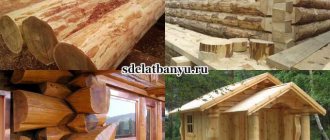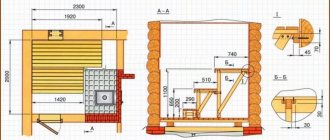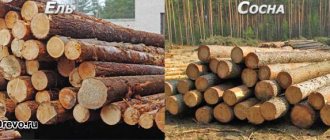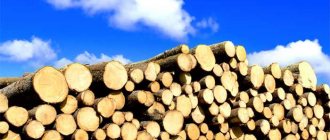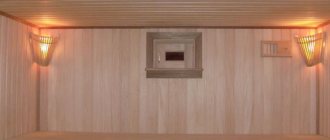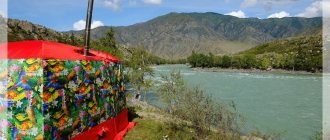The construction of a Russian bathhouse is traditionally carried out from wood of various species. But not all types of wood are suitable for building a bathhouse, so it is important to understand and understand which ones are better to choose. What kind of wood is best to build a bathhouse from, which one is suitable for finishing, we will find out why with our readers.
The wood for building a bathhouse is different. Each has its pros and cons.
Common and unusual pine trees
But before we move on to the question of the suitability of a pine bathhouse, it is worth finding out the general properties of this material and what varieties can be found on sale.
Ordinary
There are many species in the pine genus, but only a few end up on the construction market, and for Eurasia it will be Scots pine , and in America it will also be Weymouth, for example. We are interested in what can be found in Russia.
So, what would we highlight as the main thing? Since we are dealing with coniferous wood, the release of resin . And not only does it happen, but sometimes the resin flows out very intensively, forming large smudges.
This property imposes serious restrictions on the use of coniferous wood in the steam room. In all other rooms everything will be fine, but in the steam room I really don’t want to recommend either walls with a ceiling or shelves made of pine.
ADVICE! In a steam room, pine is usually used where it does not come to the surface - in the form of sheathing slats, for example, or the frame of shelves.
The second important property for us is resistance to rotting . But first it is necessary to clarify that trees are divided according to their structure into core trees and non-core trees or sapwood trees.
Some have a core - a central rod in the trunk, where cells are concentrated that no longer participate in metabolic processes, and a surrounding sapwood - living cells involved in metabolism.
Typically, heartwood and sapwood exhibit different resistance to biological attack, particularly to rot caused by fungi.
Pine has a pronounced core, and as for resistance to decay, this particular species has very high resistance both in the core and in the sapwood . In other trees, the sapwood is often more vulnerable.
The density of pine wood is average and is only 500 kg per cubic meter. The density-related hardness averages 2.49. For comparison, the hardness of birch is 3.6, oak 3.8. That is, the wood is quite soft and easy to process.
Holds nails and screws well. You can glue it. You can also stain and paint, but the release of resin can ruin everything.
To understand what material you are dealing with, it would be nice to compare the characteristics with other types of wood. We have selected those about which detailed materials can be found on our website. If you want to read about them too, follow the links.
| Physical properties | Pine | Linden | Aspen | Abash | Birch |
| Average density | 520 kg/m³ | 490–530 kg/m³ | 450 kg/m³ | 350 kg/m³ | 610–650 kg/m³ |
| Density limits | 300-860 kg/m³ | 320–600 kg/m³ | 360–600 kg/m³ | 320-700 kg/m³ | 460–830 kg/m³ |
| Longitudinal shrinkage | 0,4 % | 0,3 % | 0,4 % | no data | 0,6 % |
| Radial shrinkage | 4% | 5,5 % | 3,3 % | 3,3% | 5,3 % |
| Tangential shrinkage | 7,7 % | 9,1 % | 8,2 % | 5,6% | 7,8 % |
| Radial swelling | 0,19 % | 0,15–0,23 % | 0,13 % | no data | 0,29 % |
| Tangential swelling | 0,36 % | 0,24–0,32 % | 0,25–0,31 % | no data | 0,41 % |
| Flexural strength | 80 N/mm² | 90-106 N/mm² | 76 N/mm² | 52 N/mm² | 120 N/mm² |
| Compressive strength | 45 N/mm² | 44-52 N/mm² | 36 N/mm² | 30 N/mm² | 60 N/mm² |
| Tensile strength | 100 N/mm² | 85 N/mm² | 69 N/mm² | no data | 137 N/mm² |
Karelian
You should not think that a different pine tree grows in Karelia than in Siberia. In this case, we only talk about the area where Scots pine . Why is it singled out as something separate?
There are two reasons. Firstly, it is believed that ecology has a great influence on the quality of wood, so the cleaner the area where the wood is harvested, the higher the quality of the wood will be.
Let me not completely agree with this opinion. Let us assume that a tree in a clean area will not become an accumulator of harmful elements and their compounds. But wood is full of defects that are associated only with various episodes in the life of the tree.
They say that especially straight and tall pines . But if you take top-class products, then they will all be without defects and blemishes, clean, smooth, and it doesn’t matter where they come from. They also say that trees from this area have increased strength and resistance to rot.
Secondly, Karelian pine is often called an analogue of the Lapland dead pine kelo , baths from which have become especially popular in Finland. In this case, it is worth clarifying what kind of “Karelian pine bathhouse” is being offered to you. However, the price of a living and dead tree is very different, it is almost impossible to make a mistake.
Dry Kelo
Kelo is probably the Finnish name for dead wood. Russians call it “sugarnik”, but “kelo”, presumably, sells better.
Some will say that real kelo pine is found only in Lapland, others will expand its range to everything that can be found beyond the Arctic Circle . But the bottom line is this: with age, the root system of a tree grown in long and cold winters may lose viability. Then a particularly severe frost will strike and the roots will simply die.
And when the roots die, the tree remains standing, but it no longer receives nutrition, so it dies standing, gradually drying out. Over time, wood is formed, which has dried under natural conditions to a level acceptable for construction.
Other causes of tree death are ground fire or pests. In the first case it is still suitable, in the second it is absolutely not.
It is problematic to obtain dead wood - dry trunks are found in hard-to-reach places, there are few of them. And their quality is such that a keen eye of a specialist is needed to determine the barrel that is worth the effort of extraction and transportation, for example, by helicopter. The result is a piece product. Hence its high price.
What could be the problem? First of all, in living creatures. It is not true that insects do not like dead wood. If we didn’t love them, we wouldn’t have them in houses and furniture. On the contrary, in nature they are part of an ecosystem that recycles dead trunks. Therefore, dead wood is both home and food for them.
Wealthy Finns use kelo to build houses and saunas. Is this wood suitable for a Russian bath? Good. But heat-treated pine will be better, because not only does it have minimal humidity, but the resin will no longer be released. And kelo produces resin just like ordinary pine.
In terms of shrinkage, kelo is better than material that has undergone conventional drying, but thermowood also does not shrink, so both can be put into operation immediately after construction.
As already mentioned, in Russia an analogue of the Finnish kelo is usually offered - crackers made from Karelian pine . Let us express our hope that the specialists who select the barrels are no worse than European ones. Because an important advantage of kelo is environmental friendliness. This pine does not need to be treated with antiseptics. And if you have to get rid of insects, then no matter what the plus is.
Kelo sauna. Photo source: Remeslo company
ATTENTION! There is also a fake - this is when a tree is killed, the bark is peeled off and it is allowed to dry for a while. The period of such drying is not comparable with the period of natural drying. Therefore, in the end we get an almost ordinary log, which will shrink and can get twisted out.
And it happens that a relatively cheap dried wood - with defects in the form of insect passages, for example, and also cut down somewhere in the Moscow region, but when people hear about the dry wood, then any dead wood suddenly becomes valuable. Don’t believe it - not all dead wood is good, but only some, the rest remains waste as it was.
Finally, about kelo - watch, if interested, a video about a house with a bathhouse built from this material. Here the builders came to the customer six months after the completion of construction to ask how their log house was doing:
Dry-standing units - an elite material for construction
Probably everyone has had the opportunity to contemplate a lonely tree standing on a hill. At least everyone saw the image.
This is a classic representative of dead wood - a special type of wood suitable for building a private house. The variety can be any, but below we describe dead pine - the elite among the materials for log houses.
What is so special about this raw material? The wood receives a sufficient amount of air from all sides, the distance from the solid massif does not give a chance to parasitic insects in winter, the growth of the whip is uniform - the annual rings lie tightly. The main disadvantage of this material is the exorbitant price.
The essence of this parameter depends on the rarity of the wood; it is harvested and stored individually, awaiting wealthy clients. Karelia log cabins made from dead pine are a very expensive pleasure, considering that some species are extremely rare.
types of use of this wood in bathhouse construction
Let's move on to the options in which pine wood can be used in the construction of a bathhouse. In principle, it can be any lumber - beams and rafters, joists, sheathing are made from it, that is, it can be a log, timber, board, block . In addition, it is possible to finish the bathhouse with pine - paneling.
Log houses
A chopped bathhouse made of logs or timber may well be pine. Provided that the owner makes sure that the walls and ceiling in the steam room are finished with something that will not allow the resin to leak onto the surface.
Moreover there are fewer problems in a Russian bath than in a sauna. The temperatures there are not such that the resin flows in streams. But even in smaller quantities it can cause problems.
Therefore, the most painless option is to sheathe the steam room with hardwood paneling . Because if you make the walls of the steam room from hardwood logs, or from thermal wood, then there will be different shrinkage with all the other walls.
A log house for a bathhouse made of pine is selected according to the climatic conditions of the area - the further north you go, the thicker the logs should be. In the south, 10-15 cm is acceptable, in the middle zone - 15-20, and then only 20+.
If you plan to sheathe the steam room, you can use impregnated pine, that is, industrially treated with antiseptics (and, if desired, fire retardants). There the depth of penetration is greater than with self-processing, so it will last longer.
ADVICE! In general, use impregnations wisely, and there will be fewer problems. This means oil impregnation in the steam room, antiseptics outside (inside - only in rooms with moderate temperatures), protection from water and ultraviolet radiation - outside. Useful
Features of log houses
If a spruce log house has been treated with special compounds, its service life will greatly increase. Spruce is also the most affordable building material, and wins the competition due to its low cost. This material can be used not only for construction and exterior decoration, but also for design decoration of interior spaces, including the manufacture of furniture. This type of wood is also distinguished by bactericidal properties that protect those living in the house from many diseases. In addition, spruce does not cause allergic reactions.
Advantages and disadvantages
So, above we have already said a lot about the fact that pine is an excellent tree for construction work. Therefore, we can only repeat ourselves about the main pros and cons of a pine bathhouse.
The main advantage is the prevalence and low cost of lumber made from its wood.
The main disadvantage is resin leaks in the steam room and, possibly, on the outside, where the direct rays of the sun will be the longest.
IMPORTANT! The resin can be expelled by heating the steam room several times, or you can take thermal wood, but it will cost more than deciduous wood.
What is better for a bath: spruce or pine?
Let’s say right away that pine is better for a bathhouse, not spruce. Spruce has slightly worse characteristics.
Firstly, spruce was more knotty than pine. But knots are bad because they complicate processing, damage the tool, and can ultimately fall out, reducing either the strength or tightness of the structure.
Secondly, spruce is less dense and more susceptible to rotting .
BUT! This property is due to the smaller amount of resins. At least that's what they say. Therefore, if you choose between spruce and pine in a steam room, then spruce is better.
Thirdly, the texture of spruce is inexpressive , and pine has a very beautiful texture, but this point is purely aesthetic. As well as the attitude to the fact that spruce wood does not change its color over time - it remains light yellow, while reddish pine darkens and becomes more saturated in color.
You can combat knotiness by purchasing “Extra” class material; low resistance to fungi is compensated by impregnations with fungicides; in general, if you want to build from spruce, nothing will interfere.
By the way, the thermal conductivity of pine is slightly higher, which means that a bathhouse made of spruce is a little warmer than a bathhouse made of pine.
Material selection
When choosing timber, you should pay attention to its quality. The manufactured spruce beam must be even and smooth . You need to choose the material very carefully, because... there should be no knots on it. You also need to pay attention to the color of the log.
Spots of characteristic shades are a sign of rotting wood. The timber should be light and monochromatic without various pigmentations. It is necessary to carefully examine the timber for cracks. The fewer cracks in the wood, the longer it will last.
Reviews
Unfortunately, we were unable to find real reviews about pine baths, only individual remarks from participants in various forums, among whom were both supporters and opponents of the use of pine in the bath, and, as always, they were talking about the steam room.
There are people who say that they have never had problems with resin at all , but how can such luck be explained? Perhaps they confused pine with spruce - the latter actually cries less. Perhaps they have a Russian bathhouse and the temperature does not rise above 60 degrees. In addition, we must take into account that all the characteristics of trees are averaged, there is a scatter, and here it depends on your luck.
Why is it cold in a barrel sauna in winter?
Sometimes people complain that it is cold in the barrel sauna in winter. Now you know why this happens. If you make a barrel sauna from pine, it will a priori be cold in winter. There is no need to spend money and test it empirically; you have proof in numbers - the thermal conductivity table. Even at positive, but low temperatures, you will have to heat more to maintain the required temperature. And in sub-zero winters it is impossible to steam at all - the bathhouse will cool down very quickly.
Therefore, if you decide to buy or build a bathhouse yourself, choose cedar. And don’t throw your money away, and you will enjoy and enjoy for many years.
In addition to the fact that cedar retains heat well, it is also, unlike pine, not susceptible to mold and rot. Pine is soft, if it is not regularly treated with protective compounds, it begins to “turn blue” and rot, because Mold forms between the fibers. Although pine is the cheapest material, in this case, chasing cheapness is not the best option.
Go to the catalog and choose your barrel sauna
Pine interior
In addition to construction, pine wood is widely used in furniture making. It can also be used to create doors, window frames and more.
Furniture
Let’s immediately make a reservation that furniture for a bathhouse is made from pine, of course, but not for a steam room. It’s unlikely that anyone would want to burn themselves on a pine shelf or bench.
Otherwise, you can make anything - benches, benches, tables, chairs, sofa frames and chaise lounges. Accordingly, all this can be bought ready-made.
For those who are thinking about what furniture to put in the bathhouse, we recommend that you read the guide article, which contains links to everything that we have written about bathhouse furniture.
Doors
Can I use pine boards to make bath doors? Why not? Just take into account that the doors in the bathhouse are different - there is an entrance, there is a door to the steam room and a door to the washing room, a door to the relaxation room and a bathroom.
Where there is high humidity, it is, of course, not worth using solid pine. In general, bathhouse doors have one unpleasant feature: due to humidity, they change their dimensions and may not fit into the doorway. And when they dry out after swelling, cracking is possible, which is also not good.
To prevent the door from changing dimensions and drying out, it is usually made of linden. There is an opinion that a fake door never creates problems, opening and closing perfectly, regardless of the procedures. A door to a pine bathhouse cannot boast of such quality, since moisture causes it to significantly increase in size.
The second problem with doors is that they can lead. Since we were already interested in the prospect of correcting a warped door, we can say that this is almost a lost cause - some correction can be achieved with the help of wetting and pressure, but this will not last long, because the defect appears at the stage of initial drying and then cannot be straightened out, the door often has to be replaced. Grinding doesn't solve the problem with the gaps on the other side, so it's not an option.
ADVICE! Warping must be monitored at the stage of selecting a material or a finished door.
In general, make the door to the steam room and washing room from linden, the rest is up to your discretion, although we saw doors from pine lining to the steam room - it was fine, one plank was damaged, the rest were unchanged. For more information about doors, see the section on doors for baths and saunas.
Brooms
Bath brooms are made from a wide variety of branches and herbs, each for a specific purpose .
A pine bath broom releases a lot of essential oils when steaming, so its aroma is very strong. By inhaling it, you simultaneously disinfect the respiratory tract , which will be a good prevention of colds. The smell of pine needles also has a tonic effect on the entire body - after the procedures you feel a great surge of strength and vigor.
While hovering with such a broom, the body receives its benefits - this is a massage, a tingling sensation that causes a rush of blood to the skin, and the transfer of beneficial substances that the pine needles contain to the skin.
According to the rules, the broom is prepared right before the procedure from straight, young branches. It is advisable to wrap the handle or use gloves, because resin will be released.
The broom is not steamed, but is poured with boiling water for a quarter of an hour . Afterwards, you can wrap it in cloth and put it on the top shelf for another five minutes. Under the influence of boiling water, the needles will become softer, their touch will become more pleasant.
ATTENTION! This broom can only be used once. Its usefulness is one-time only.
If resin gets on your skin during the procedures, you don’t need to do anything - then wipe it off with alcohol.
